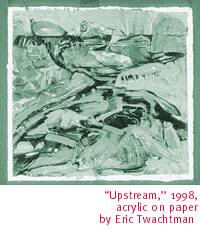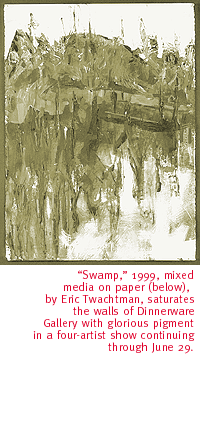

|

A Trio Of Dinnerware Artists Bring Contemporary Art Back To The Canvas With Their End-Of-Season Show.
By Margaret Regan
PAINTING ISN'T DEAD, after all. At the end of a season
that has lionized the making of art from such exotica as metal
debris and discarded underwear, Dinnerware has mounted a show
that celebrates the fine old art of painting. That's right: the
application of pigment to a surface with a brush. The three painters
exhibiting, Eric Twachtman, William Blomquist and Michael Chittock,
mostly use time-honored materials--oils, acrylics, watercolors,
gouache--and for the most part they apply them to old-fashioned
canvas and paper. Their skills vary, but there's no question that
they are doing their bit to keep the old art alive.
Twachtman even comes from a family tradition of painting. He's
the great-grandson of American painter John Henry Twachtman, who
lived from 1853 to 1902. Under the spell of Impressionism, the
elder Twachtman created "exquisite, atmospheric landscapes
in oil and pastel," according to one authority. Eric says
his grandfather's art never brought much success though, and the
family never particularly encouraged the younger Twatchman to
pick up a brush.

 But he looked every inch the painter when he happened by the
gallery the other day, all disheveled hair and spattered T-shirt.
He didn't take up art seriously until after completing an English
major, he said; only after college graduation did he enroll in
art school. The late start didn't keep him from following in his
forebear's landscape footsteps, though his aesthetic is his own.
His works are more expressionistic than impressionistic, and they
have a contemporary environmental undertone.
But he looked every inch the painter when he happened by the
gallery the other day, all disheveled hair and spattered T-shirt.
He didn't take up art seriously until after completing an English
major, he said; only after college graduation did he enroll in
art school. The late start didn't keep him from following in his
forebear's landscape footsteps, though his aesthetic is his own.
His works are more expressionistic than impressionistic, and they
have a contemporary environmental undertone.
"Witnessing the ever-accelerating destruction of nature
makes portraying it even more sacred to me," Twachtman wrote
in an artist's statement for the Dinnerware show. "Responding
to this with paint is my life's ambition."
Twachtman takes his inspiration from the Sonoran desert, from
ocean dunes, and from murky pools in forests. But his paintings
are hardly realistic evocations of these familiar haunts. Instead,
they're intensely emotional responses to place, wild slashes of
color that hover unabsorbed on the painting surfaces, manipulated
by brushes, scratchy points, and sometimes the artist's finger-painting.
They're deconstructions of hallowed nature. The real-life swamp
immortalized in "Swamp," a 1999 mixed media on paper,
became watery deep-dark greens against a pale, yellow-green sky.
The mirror images of plants and their watery reflections are abstracted
into bold vertical lines.
"Monsoon," a 1998 acrylic on canvas, travels even further
from representation. The storm's black cloud is reduced to a curling
shape against an orange-red sky, and the spiky desert below has
become loose drips of turquoise paint pooling into lime green.
Likewise, "Dune" doesn't get the conventional seashore
treatment, though its parts are more recognizable. It has a nice,
dramatic composition. The summit of the dune towers high above
the focal point; and, as is typical of Twachtman, the perspective
is flattened out. The teeming grasses are translated into swirls
and scratches of paint, all black, gray and green, lightened by
bursts of pink and orange.
Twachtman's colors are intense. Cherry red slices through the
middle of "Bog," a 1999 mixed media on paper; bands
of blue, green and pink stand in for the receding layers of the
landscape. Deep black and blue-green alternate in "Black
Rock," another 1999 mixed media on paper. "Still Hill,"
a mixed media on paper from 1998, is moodily dark, with greens
so deep they're almost black. Perhaps the most beautiful is "Sonora,"
1999, the largest painting Twachtman's exhibiting at about 4-by-5
feet. Here he adapts our beloved desert into a watery cascade
of colors: nature's rock-rigid mountains liquefy into the desert's
cascading green cacti, all limpid and lovely.
 Blomquist works the old dodge of oil on canvas or panel; but
his imagery, what he calls "emotional architecture,"
is quite contemporary. He generally paints some kind of central
figure--a vaguely human shape, a plant, a sail, or some indefinable
object--against a background divided into geometric space. "Hummingbird,"
a 1999 oil on panel, has an intricate composition of horizontal,
vertical and diagonal shapes, framing an off-center, narrow rectangle
that encloses flowers and other objects unknown.
Blomquist works the old dodge of oil on canvas or panel; but
his imagery, what he calls "emotional architecture,"
is quite contemporary. He generally paints some kind of central
figure--a vaguely human shape, a plant, a sail, or some indefinable
object--against a background divided into geometric space. "Hummingbird,"
a 1999 oil on panel, has an intricate composition of horizontal,
vertical and diagonal shapes, framing an off-center, narrow rectangle
that encloses flowers and other objects unknown.
Blomquist knows what he's doing with his paint, deploying
all the centuries-old tricks. He transforms his flat surfaces
into illusionistic, three-dimensional space. He softens and blends
with the brush, so that every line is thick and palpable with
color. Most pleasing of all, he knows how to put color against
color--yellow against cerulean blue--to luscious effect. In "Hummingbird,"
a dark green undercoat pumps up the lemon yellow and tan on the
surface.
Chittock is the contemporary rebel of this painterly trio,
delving into new media, mixing his acrylic paints with sawdust
and ash to force his images off the canvas. His paintings are
thick, three-dimensional affairs, highly stylized desert landscapes
and cartoonish figures in interior places. The landscapes are
rather nice, but his technique works against his paint. The sawdust
and ash rob his acrylics of their sheen, making the bumpy surfaces
seem lumpen and static. The paint, which deserves to flow across
space, seems trapped.
Livelier and more successful are Chittock's playful forays into
painting on cut metal. In "Fish Pond," three painted
metal goldfish cavort several inches above their home base, a
flat painted pond in which the ripples have been cut out and distributed
among the leaping fish. He's also made a fine series of portraits
in oil pastel, "Sleeping," a chronicle of a friend's
long night in the hospital. It's a prodigious group of 14 drawings,
each dated by the hour and minute, lovingly depicting the sleeping
man as he tosses around his sickbed. Chittock drew the pictures
on pages of The New York Times.
The headlines and photos of the newspaper intrude in interesting
ways into the drawings, making the series a marriage of techniques
old and new. The very contemporary found material--cheap newsprint--collaborates
with the time-honored pastels.
An exhibition of paintings by Eric Twachtman and William
Blomquist, paintings and sculpture by Michael Chittock,
and sculpture by Stacy Blackmer-Blomquist continues through
Tuesday, June 9, at Dinnerware Contemporary Art Gallery,
135 E. Congress St. Gallery hours are noon to
5 p.m. Tuesday and Wednesday; noon to 7 p.m. Thursday; and noon
to 9 p.m. Friday and Saturday. For more information, call 792-4503.

|
 |





